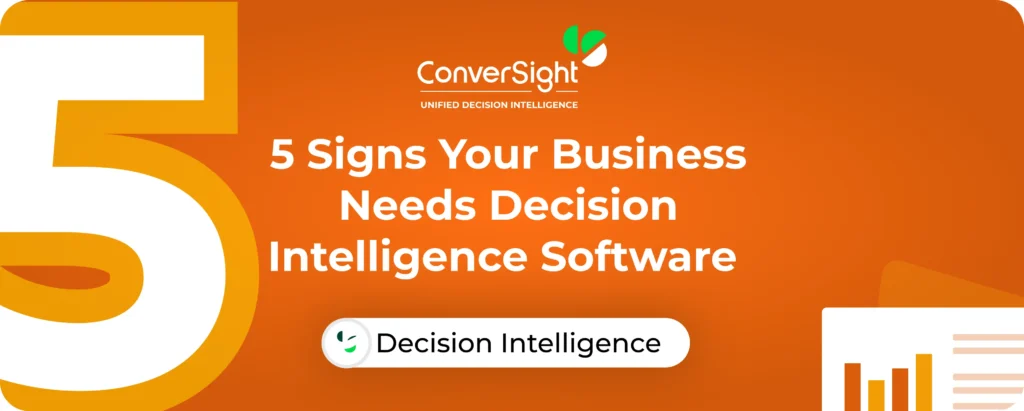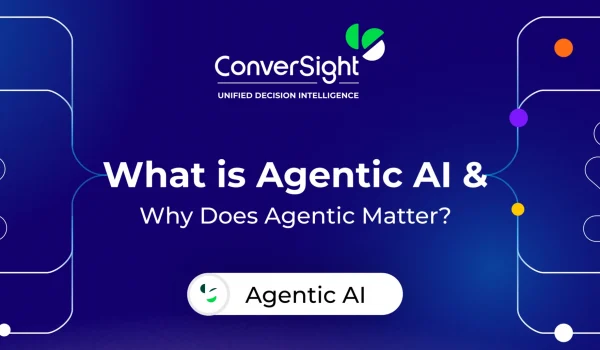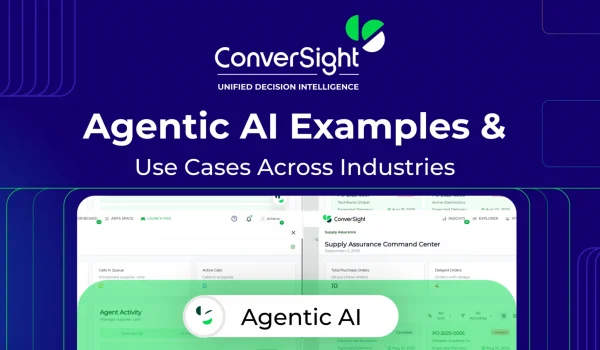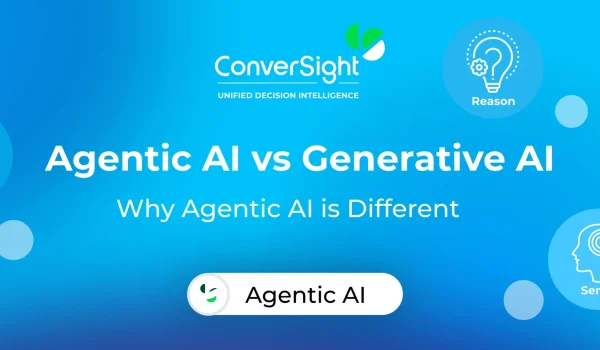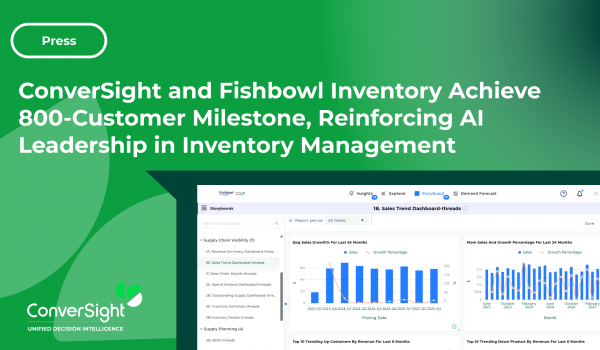Recognize the warning signs that your business is ready for a decision intelligence upgrade.
Are You Making Decisions in the Dark?
Every business leader knows the pressure of making the right call when the stakes are high. Yet, despite having more data than ever before, many organizations find themselves second-guessing decisions, overwhelmed by endless reports, or stuck waiting too long to act. The result? Missed opportunities, wasted resources and strategies built on shaky ground.
Data on its own isn’t the problem—what’s missing is the ability to transform that data into confident action. This is where decision intelligence software comes in. It doesn’t just display numbers; it interprets them, connects the dots, and provides clear direction. Instead of asking “What happened?” or “Why did it happen?”, businesses can start asking “What should we do next?” and get actionable answers in real time.
In this blog, we’ll uncover five signs your business might already be ready for decision intelligence software. If any of these scenarios sound familiar, it may be time to rethink how your organization approaches decisions.
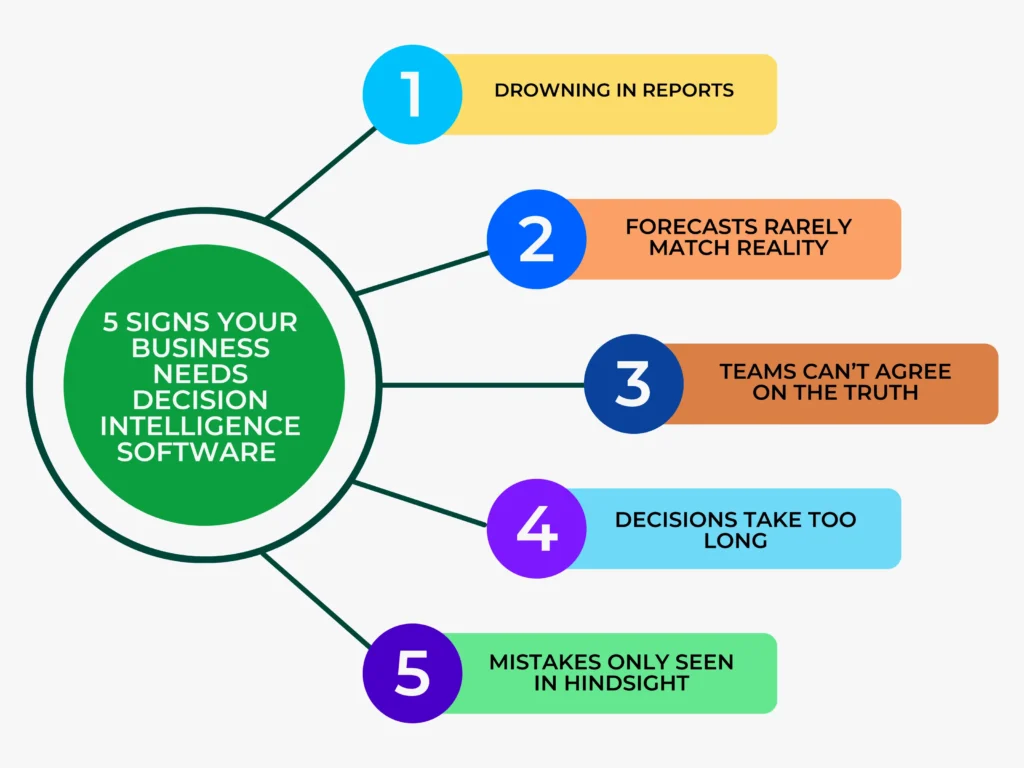
Sign 1: You’re Drowning in Reports but Still Don’t Have Clear Answers
Every week, teams spend hours compiling spreadsheets, reviewing dashboards, and presenting charts. On the surface, it feels like progress—data is being tracked, metrics are being measured, and reports are being shared. But when it comes time to make a critical decision, the clarity is often missing. Leaders still find themselves asking, “So what do we actually do next?”
This is the classic trap of data overload. Too many reports present information in fragments, without connecting the dots. You might know that sales are declining in one region or that costs are rising in a product line, but without context, these insights remain incomplete. Decision-making stalls because the numbers don’t translate into direction.
Decision intelligence software bridges that gap. Instead of overwhelming you with charts, it interprets the data, highlights what matters, and suggests the best course of action. For example, rather than simply showing that demand has dropped, the system could recommend reallocating inventory, adjusting pricing, or boosting promotions in a specific region. The result: faster, more confident decisions, fewer wasted hours digging through endless dashboards, and a clear path forward when it matters most.
Sign 2: Your Forecasts Rarely Match Reality
Forecasts are meant to guide decisions, but too often they become a source of frustration. Budgets overshoot, inventory falls short, and revenue projections miss the mark. When actual performance consistently strays from predicted outcomes, it erodes confidence in planning and makes leaders hesitant to rely on their data.
The issue usually lies in how forecasts are built. Traditional forecasting often depends on static historical data, gut instincts, or siloed spreadsheets. This approach can’t keep pace with today’s rapidly shifting market conditions—unexpected demand surges, supply chain disruptions, or sudden cost changes. The result? Plans that look good on paper but collapse when tested.
This is where decision intelligence software powered by predictive analytics steps in. By analyzing large volumes of real-time and historical data, it not only improves the accuracy of forecasts but also models multiple “what-if” scenarios. Instead of guessing how a change in demand or pricing might affect outcomes, businesses can test scenarios instantly and adjust strategies before problems arise.
Key benefits include:
- Higher forecast accuracy: AI-driven models learn from past patterns and real-time signals.
- Faster adjustments: Plans can be updated dynamically as new data flows in.
- Scenario modelling: Test different outcomes—such as a supply shortage or a demand spike—before making a move.
- Actionable recommendations: Move beyond numbers to concrete next steps.
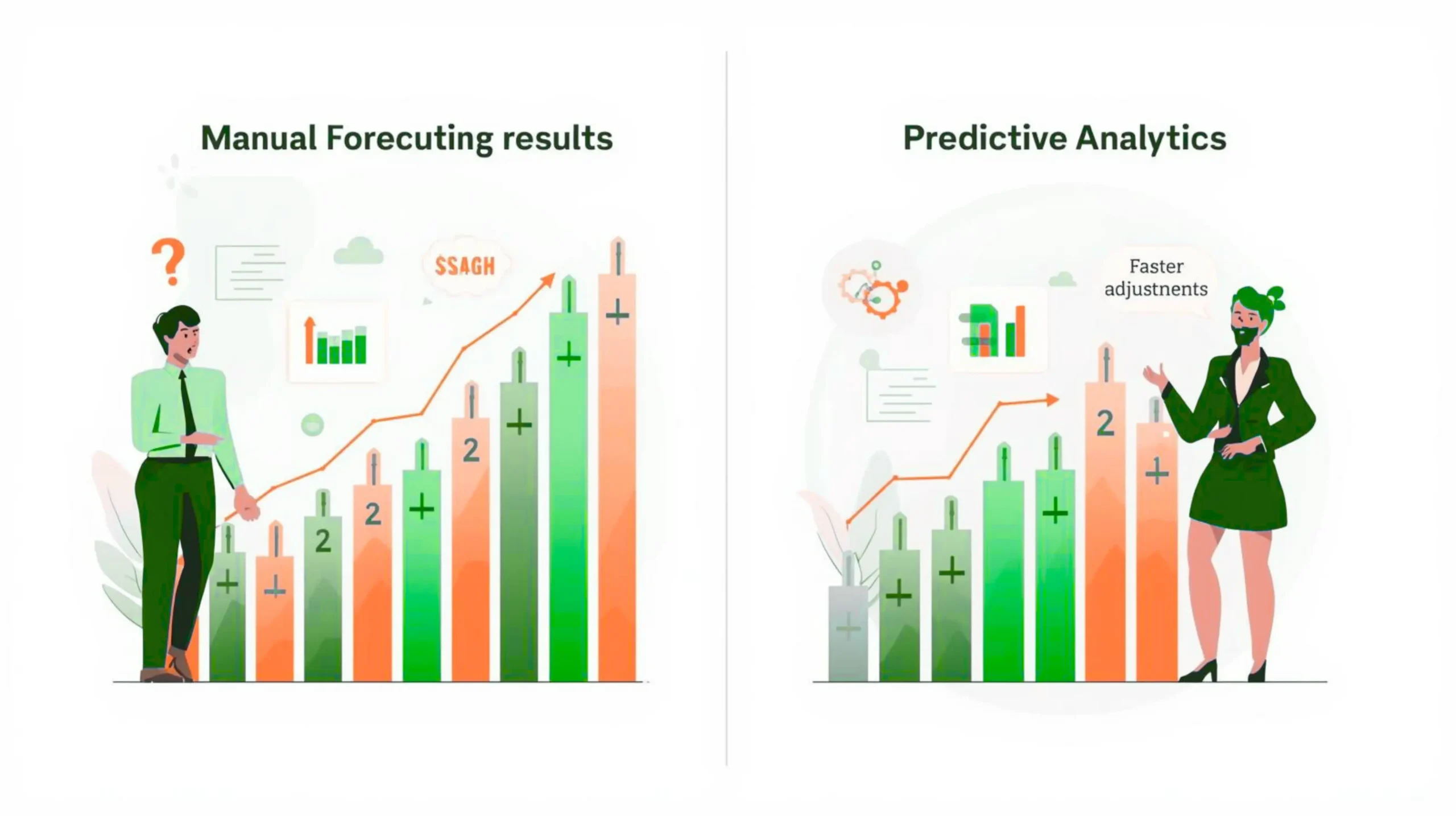
Sign 3: Your Teams Can’t Agree on a Single Version of the Truth
In today’s interconnected global economy, supply chains face unprecedented challenges. A survey found that 93% of Few things slow down decision-making more than conflicting numbers. Sales might report one revenue figure, finance presents another, and operations tracks something entirely different. Meetings that should be about strategy often turn into debates over whose spreadsheet is correct. The result? Frustration, wasted time, and decisions based on partial or outdated information.
This happens because data lives in silos. Each department manages its own reports, often using different tools, formats, and assumptions. Without a unified system, aligning on the “real” number becomes a challenge—and by the time consensus is reached, the opportunity to act may already be gone.

Decision intelligence software solves this by creating a single source of truth. All data flows into a unified framework where it is standardized, contextualized, and made accessible across the organization. Instead of reconciling numbers, teams can focus on analyzing insights and taking action. Everyone—from finance to operations—works from the same foundation, ensuring consistency and trust in the decisions being made.
Sign 4: Decisions Take Too Long (and You Miss Opportunities)
Speed matters. In competitive markets, the difference between acting today versus next week can mean winning a customer or losing them to a competitor. Yet in many organizations, decision-making is painfully slow. Reports need to be pulled, numbers validated, insights presented, and approvals routed through multiple layers of management. By the time a decision is finalized, the opportunity has already passed.
This lag often happens because:
- Data is scattered: Teams waste time collecting and cleaning information from multiple systems.
- Too many steps: Decisions require multiple handoffs, approvals, or committee discussions.
- Reactive approach: Leaders wait for problems to escalate before acting, instead of proactively addressing them.
Decision intelligence software accelerates this entire cycle. By providing real-time insights and recommendations, it cuts down the time between identifying an issue and deciding on the best course of action. Approvals become streamlined when all stakeholders can see the same data-backed recommendation at once. The outcome is agility: faster pivots, quicker responses to market shifts, and the ability to seize opportunities before they slip away.
Sign 5: You Often Realize Mistakes Only in Hindsight
One of the most frustrating realities in business is realizing a mistake only after it has already caused damage—whether it’s a missed sales opportunity, a supply chain disruption, or an unexpected cost overrun. At that point, the only option is damage control. While lessons can be learned, the cost—in revenue, reputation, or time—is already sunk.
This reactive approach happens when organizations lack the ability to detect risks early. Decisions are made based on limited data, blind spots remain unnoticed, and by the time the full picture emerges, it’s too late.
Decision intelligence software shifts this pattern from reactive to proactive. With built-in risk detection, anomaly alerts, and “what-if” simulations, it enables businesses to spot potential issues before they escalate. For example, the system can flag unusual demand patterns, warn about supplier delays, or simulate the impact of pricing changes—all in real time.
This means leaders don’t just respond to problems; they prevent them. Instead of discovering a mistake in hindsight, they can evaluate multiple paths forward and choose the one that minimizes risk and maximizes opportunity.
Some proactive capabilities include:
- Real-time alerts when data shows unusual trends or anomalies.
- What-if scenario modeling to test outcomes before committing.
- Risk heatmaps that highlight vulnerabilities across operations.
The result is fewer surprises, better resilience, and a culture where mistakes are avoided rather than constantly cleaned up after the fact.
Bringing It All Together with ConverSight
To overcome these challenges, businesses need tools that make intelligent decision-making faster and easier — and that’s where ConverSight comes in.
The fastest way to experience the power of decision intelligence is through ConverSight’s QuickStart AI Solutions—a suite of plug-and-play decision intelligence tools designed for supply chain, finance, and sales teams. Unlike traditional BI projects that take months to deliver insights, QuickStart AI enables organizations to go live in as little as 1–6 weeks, with pre-built dashboards, KPIs, and AI forecasting models ready from day one.

Each QuickStart solution is tailored to unlock measurable outcomes across business functions:
- Sales Analytics: Track revenue trends, customer segmentation, and product performance in real time to accelerate growth.
- Finance Analytics: Replace manual reporting with automated P&L, balance sheet, and cash flow insights for faster decision-making.
- Supply Chain Visibility: Achieve end-to-end transparency into vendors, spend, and inventory to identify risks early.
- Demand Planning: Forecast with precision using AI-driven models that minimize stockouts and optimize inventory.
- Supply Planning: Automate procurement workflows and production planning with smart recommendations powered by AI.
QuickStart AI helps organizations see ROI faster—not in months, but in days or weeks—turning data into instant intelligence that drives results.
While QuickStart AI provides a foundation for fast, outcome-driven adoption, ConverSight’s unified decision platform takes this capability even further. It doesn’t just manage data—it makes it actionable through Athena, ConverSight’s conversational AI assistant. Decision-makers can simply ask questions and receive clear, contextual insights in seconds, without needing technical expertise. Whether it’s identifying why forecasts are missing the mark, uncovering supply chain inefficiencies, or aligning cross-departmental data, ConverSight empowers teams to act confidently.
- Natural language interface: Ask questions in plain English and get real-time insights instantly.
- Predictive & prescriptive analytics: Run simulations, optimize plans, and prepare for future outcomes with confidence.
- Collaboration at scale: Enable every department to work from a single, trusted source of truth.
- Explainability tools: Understand not just what the AI recommends—but why.
See how ConverSight empowers businesses to make smarter decisions. Explore the platform at ConverSight.ai.
Final Thoughts: Smarter Decisions Start Now
From drowning in endless reports to discovering mistakes only after it’s too late, the challenges we covered are all signs that your business is ready for a change. If your forecasts rarely match reality, if teams can’t agree on a single version of the truth, or if decision cycles are so slow that opportunities slip through your fingers—these are clear signals that traditional approaches to data and analytics are no longer enough.
Decision intelligence software comes in; by unifying data, applying predictive and prescriptive analytics and delivering actionable recommendations in real time, it transforms decision-making from a reactive chore into a proactive advantage. The organizations that act now will be the ones who lead tomorrow—because in business, smarter and faster decisions often make the difference between keeping up and staying ahead.
Ready to experience the power of decision intelligence software in your business? Book a Demo!
